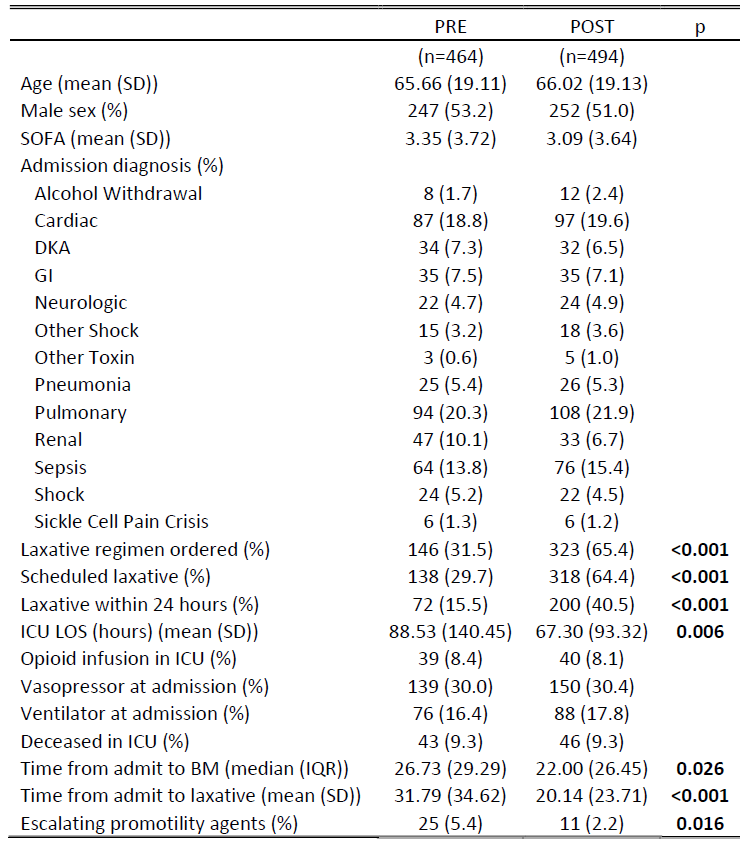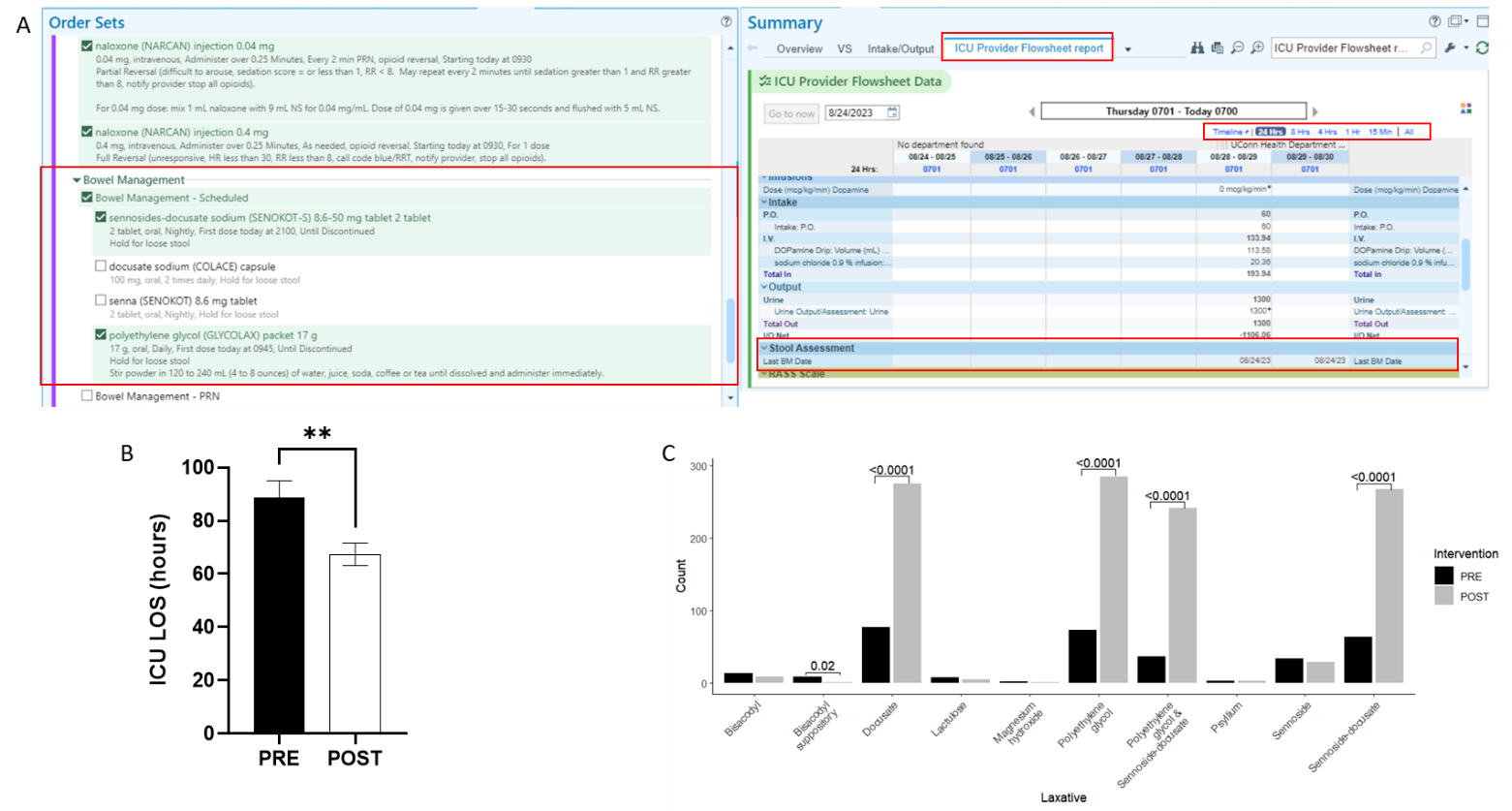Sunday Poster Session
Category: Functional Bowel Disease
P0816 - Increasing Utilization of Laxatives in the Medical ICU Leads to Reduced Length of Stay and Reduced Use of Escalating Laxative Agents
Sunday, October 26, 2025
3:30 PM - 7:00 PM PDT
Location: Exhibit Hall
- CC
Christopher Costa, MD (he/him/his)
University of Connecticut Health
Rochester, MN
Presenting Author(s)
Christopher Costa, MD1, Rachael Hagen, DO2, Raymond Foley, DO2
1University of Connecticut Health, Rochester, MN; 2University of Connecticut Health, Farmington, CT
Introduction: ICU associated delay in GI transit is a commonly encountered complication of critical illness. Prophylactic use of laxatives has been shown to help reduce incidence of this condition and related complications. We have sought to increase prophylactic laxatives usage in the medical intensive care unit (MICU) with the goal of reducing occurrence of ICU associated constipation (greater than 72 hours without bowel movements), reducing reactive use of laxatives, and improving patient outcomes.
Methods: A scheduled laxative regimen consisting of polyethylene glycol and sennoside-docusate was added to the MICU admission order set, with these agents selected for scheduled daily administration. At their discretion, clinicians were able to withhold or discontinue these orders. Additionally, reporting of bowel movements was made more visible within the electronic medical record (Figure 1A). These interventions were granted exempt status by the institutional review board at UConn Health. Six months of pre and post intervention data were collected between September and March 2022-2023 and 2023-2024, respectively. Age, sex, admission diagnosis, laxative regimen, time to first bowel movement, ICU length of stay, and history of constipation were recorded for each patient. Data was analyzed in R Statistical Software with Student’s t test or Wilcoxon Signed Rank test for continuous variables and X2 or Fisher’s exact test for categorical comparisons.
Results: Post-intervention, utilization of laxative regimens ordered in a scheduled fashion and administered in a prophylactic fashion (i.e., within the first 24 hours of admission) doubled (Table 1), a significant increase from prior. Notably, the mean ICU length of stay was decreased (mean difference= 21.2 hours, t=2.74, df=779, p=0.006) following adoption of the intervention (Figure 1B). Most laxative agents used were those included in the order set (X2=125, df=1, p< 0.001) (Figure 1C). There was no reduction in incidence of ICU associated constipation (X2= 0.714, df=1, p=0.4).
Discussion: The number of ICU patients with prophylactic laxative regimens has been increased. Decreased length of stay and reduced need for rescue and escalating pro-motility agents demonstrate patient benefits of these interventions. This is a promising first step in reducing the burden of delayed bowel movements in the medical ICU.

Figure: Table 1. Pre- and post- intervention group characteristics. Notably, there are no differences in age, sex, SOFA scores, and admitting diagnosis distributions between groups. All listed p-values represent the result of Student’s t tests or Wilcoxon Signed Rank Tests for continuous variables and Chi squared tests for categorical variables.

Figure: Figure 1. (A) Screen shots from EPIC electronic medical record showing the new pre-selected laxative orders within the ICU admission order set (left) along with the increased “Last BM Date” visibility within the ICU Provider flowsheet (right). (B) ICU length of stay has decreased following implementation of our laxative regimen, with reduced variability. (C) Laxative usage post-intervention has shifted towards the agents included in the order set, polyethylene glycol and sennoside-docusate. p-values are displayed.
Disclosures:
Christopher Costa indicated no relevant financial relationships.
Rachael Hagen indicated no relevant financial relationships.
Raymond Foley indicated no relevant financial relationships.
Christopher Costa, MD1, Rachael Hagen, DO2, Raymond Foley, DO2. P0816 - Increasing Utilization of Laxatives in the Medical ICU Leads to Reduced Length of Stay and Reduced Use of Escalating Laxative Agents, ACG 2025 Annual Scientific Meeting Abstracts. Phoenix, AZ: American College of Gastroenterology.
1University of Connecticut Health, Rochester, MN; 2University of Connecticut Health, Farmington, CT
Introduction: ICU associated delay in GI transit is a commonly encountered complication of critical illness. Prophylactic use of laxatives has been shown to help reduce incidence of this condition and related complications. We have sought to increase prophylactic laxatives usage in the medical intensive care unit (MICU) with the goal of reducing occurrence of ICU associated constipation (greater than 72 hours without bowel movements), reducing reactive use of laxatives, and improving patient outcomes.
Methods: A scheduled laxative regimen consisting of polyethylene glycol and sennoside-docusate was added to the MICU admission order set, with these agents selected for scheduled daily administration. At their discretion, clinicians were able to withhold or discontinue these orders. Additionally, reporting of bowel movements was made more visible within the electronic medical record (Figure 1A). These interventions were granted exempt status by the institutional review board at UConn Health. Six months of pre and post intervention data were collected between September and March 2022-2023 and 2023-2024, respectively. Age, sex, admission diagnosis, laxative regimen, time to first bowel movement, ICU length of stay, and history of constipation were recorded for each patient. Data was analyzed in R Statistical Software with Student’s t test or Wilcoxon Signed Rank test for continuous variables and X2 or Fisher’s exact test for categorical comparisons.
Results: Post-intervention, utilization of laxative regimens ordered in a scheduled fashion and administered in a prophylactic fashion (i.e., within the first 24 hours of admission) doubled (Table 1), a significant increase from prior. Notably, the mean ICU length of stay was decreased (mean difference= 21.2 hours, t=2.74, df=779, p=0.006) following adoption of the intervention (Figure 1B). Most laxative agents used were those included in the order set (X2=125, df=1, p< 0.001) (Figure 1C). There was no reduction in incidence of ICU associated constipation (X2= 0.714, df=1, p=0.4).
Discussion: The number of ICU patients with prophylactic laxative regimens has been increased. Decreased length of stay and reduced need for rescue and escalating pro-motility agents demonstrate patient benefits of these interventions. This is a promising first step in reducing the burden of delayed bowel movements in the medical ICU.

Figure: Table 1. Pre- and post- intervention group characteristics. Notably, there are no differences in age, sex, SOFA scores, and admitting diagnosis distributions between groups. All listed p-values represent the result of Student’s t tests or Wilcoxon Signed Rank Tests for continuous variables and Chi squared tests for categorical variables.

Figure: Figure 1. (A) Screen shots from EPIC electronic medical record showing the new pre-selected laxative orders within the ICU admission order set (left) along with the increased “Last BM Date” visibility within the ICU Provider flowsheet (right). (B) ICU length of stay has decreased following implementation of our laxative regimen, with reduced variability. (C) Laxative usage post-intervention has shifted towards the agents included in the order set, polyethylene glycol and sennoside-docusate. p-values are displayed.
Disclosures:
Christopher Costa indicated no relevant financial relationships.
Rachael Hagen indicated no relevant financial relationships.
Raymond Foley indicated no relevant financial relationships.
Christopher Costa, MD1, Rachael Hagen, DO2, Raymond Foley, DO2. P0816 - Increasing Utilization of Laxatives in the Medical ICU Leads to Reduced Length of Stay and Reduced Use of Escalating Laxative Agents, ACG 2025 Annual Scientific Meeting Abstracts. Phoenix, AZ: American College of Gastroenterology.

